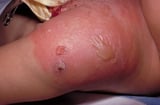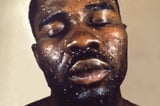Why My 6 Months Old Baby Got Fever 8 Days After She Was on Antibiotics
Although parents oft worry nearly how loftier the temperature is, the height of the fever does not necessarily indicate how serious the crusade is. Some pocket-size illnesses crusade a high fever, and some serious illnesses cause only a mild fever. Other symptoms (such as difficulty breathing, confusion, and non drinking) indicate the severity of illness much improve than the temperature does. However, a temperature over 106° F (about 41° C), although quite rare, tin can itself be dangerous.
Fever tin can exist useful in helping the body fight infection. Some experts think that reducing fever tin can prolong some disorders or perhaps interfere with the immune system'southward response to infection. Thus, although a fever is uncomfortable, it does not always require handling in otherwise good for you children. However, in children with a lung, heart, or brain disorder, fever may crusade problems considering it increases demands on the body (for example, by increasing the middle rate). So lowering the temperature in such children is important.
Fever occurs in response to infection, injury, or inflammation and has many causes. Likely causes of fever depend on whether it has lasted xiv days or less (acute) or more than 14 days (chronic), as well as on the age of the child. Fevers are usually acute.
The nigh common causes of astute fever are
-
Respiratory infections due to a virus, such as colds or flu
Less common causes of acute fevers include side effects of vaccinations and of certain drugs, bacterial infections of the peel (cellulitis Cellulitis Cellulitis is a spreading bacterial infection of the skin and the tissues immediately below the skin. This infection is nearly frequently caused past streptococci or staphylococci. Redness, pain, and... read more than  ) or joints (septic arthritis Infectious Arthritis Infectious arthritis is infection in the fluid and tissues of a joint normally acquired past bacteria simply occasionally by viruses or fungi. Bacteria, viruses, or fungi may spread through the bloodstream... read more ), encephalitis Encephalitis Encephalitis is inflammation of the encephalon that occurs when a virus straight infects the brain or when a virus, vaccine, or something else triggers inflammation. The spinal cord may also be involved... read more , and viral or bacterial infections of the brain (Kawasaki disease Kawasaki Disease Kawasaki illness causes inflammation of blood vessels throughout the body. The crusade of Kawasaki disease is unknown but may be associated with an infection. Children typically take fever, rash... read more
) or joints (septic arthritis Infectious Arthritis Infectious arthritis is infection in the fluid and tissues of a joint normally acquired past bacteria simply occasionally by viruses or fungi. Bacteria, viruses, or fungi may spread through the bloodstream... read more ), encephalitis Encephalitis Encephalitis is inflammation of the encephalon that occurs when a virus straight infects the brain or when a virus, vaccine, or something else triggers inflammation. The spinal cord may also be involved... read more , and viral or bacterial infections of the brain (Kawasaki disease Kawasaki Disease Kawasaki illness causes inflammation of blood vessels throughout the body. The crusade of Kawasaki disease is unknown but may be associated with an infection. Children typically take fever, rash... read more  ), the tissues covering the encephalon (meningitis Meningitis in Children Bacterial meningitis is a serious infection of the layers of tissue covering the brain and spinal cord (meninges). Bacterial meningitis in older infants and children commonly results from bacteria... read more ), or both. Heatstroke Heatstroke Heatstroke is a life-threatening status that results in very high body temperature and malfunction of many organ systems. (Encounter as well Overview of Heat Disorders.) Heatstroke can develop later... read more causes a very high body temperature.
), the tissues covering the encephalon (meningitis Meningitis in Children Bacterial meningitis is a serious infection of the layers of tissue covering the brain and spinal cord (meninges). Bacterial meningitis in older infants and children commonly results from bacteria... read more ), or both. Heatstroke Heatstroke Heatstroke is a life-threatening status that results in very high body temperature and malfunction of many organ systems. (Encounter as well Overview of Heat Disorders.) Heatstroke can develop later... read more causes a very high body temperature.
Chronic fever near unremarkably results from
-
A prolonged viral illness
-
Back-to-dorsum viral illnesses, especially in immature children
Chronic fever can likewise be caused by many other infectious and noninfectious disorders.
Infectious causes of chronic fever include
-
Infections of the digestive tract caused by bacteria or parasites
Noninfectious causes of chronic fever include
-
Juvenile idiopathic arthritis or other connective tissue disorders
Detecting a fever is not difficult, but determining its crusade can exist.
Certain symptoms are cause for business organization. They include
-
Any fever in infants less than 2 months old
-
Lethargy or listlessness
-
Sick appearance
-
Difficulty breathing
-
Haemorrhage in the pare, appearing equally tiny ruddy majestic dots (petechiae) or splotches (purpura)
-
Continuous crying in an baby or toddler (inconsolability)
-
Headache, cervix stiffness, defoliation, or a combination in an older child
Children with fever should be evaluated by a physician correct away if they have any alarm signs or are less than 2 months old.
Children without warning signs who are between three months and iii years of age should be seen by the md if the fever is 102.2° F (39° C) or higher, if there is no obvious upper respiratory infection (that is, children are sneezing and accept a runny nose and nasal congestion), or if the fever has connected more than than 5 days.
For children without warning signs who are over iii years of historic period, the need for and timing of a md's evaluation depend on the child's symptoms. Children who have upper respiratory symptoms but otherwise appear well may non need farther evaluation. Children over 3 years of age with fever lasting more than five days should be seen by the physician.
As doctors examine children, they expect for alert signs (such every bit an ill appearance, lethargy, listlessness, and inconsolability), noting particularly how children respond to being examined—for example, whether children are listless and passive or extremely irritable.
Occasionally, the fever itself can cause children to have some of the warning signs including lethargy, listlessness, and sick advent. Doctors may give children fever-reducing drugs (such every bit ibuprofen) and reevaluate them one time the fever is reduced. Information technology is reassuring when lethargic children become active and playful one time the fever is reduced. On the other hand, it is worrisome when ill-actualization children remain sick-appearing despite a normal temperature.
In infants betwixt 1 month and 3 months one-time, blood tests, tests of urine (urinalysis Urinalysis and Urine Culture Urinalysis, the testing of urine, may exist necessary in the evaluation of kidney and urinary tract disorders and can as well assistance evaluate bodywide disorders such as diabetes or liver problems. A... read more  ), and cultures of urine are done. The need for hospitalization, a chest ten-ray, and a spinal tap depends on results of the examination and blood and urine tests, also as how ill or well infants appear and whether a follow-upward test can be done. Testing in infants under 3 months former is done to look for bacteremia, urinary tract infections, and meningitis. Testing is necessary considering the source of fever is difficult to decide in infants and because their immature immune system puts them at high risk of serious infection.
), and cultures of urine are done. The need for hospitalization, a chest ten-ray, and a spinal tap depends on results of the examination and blood and urine tests, also as how ill or well infants appear and whether a follow-upward test can be done. Testing in infants under 3 months former is done to look for bacteremia, urinary tract infections, and meningitis. Testing is necessary considering the source of fever is difficult to decide in infants and because their immature immune system puts them at high risk of serious infection.
If children age 3 months to iii years look well and can be watched closely, tests may non be needed. If symptoms suggest a specific infection, doctors practise the advisable tests. If children take no symptoms suggesting a specific disorder but look ill or have a temperature of 102.2° F (39° C) or college, blood and urine tests are ordinarily done. The need for hospitalization depends on how well or ill children wait and whether a follow-up exam tin can exist done in a timely fashion.
In children over three years of historic period, tests are typically not done unless children accept specific symptoms suggesting a serious disorder.
If the fever results from a disorder, that disorder is treated. Other fever treatment is focused on making children experience better.
Ways to help children with a fever experience amend without using drugs include
-
Putting cool, wet cloths (compresses) on their forehead, wrists, and calves
-
Placing children in a warm bath (only slightly cooler than the temperature of the child)
Because shivering may actually enhance the child's temperature, methods that may crusade shivering, such as undressing and cold baths, should not be used.
Fever in an otherwise healthy child does non necessarily require treatment. Nevertheless, drugs chosen antipyretic drugs may brand children feel improve by lowering the temperature. These drugs do not accept whatsoever consequence on an infection or other disorder causing the fever. However, if children have a heart, lung, brain, or nervus disorder or a history of seizures triggered by fever, using these drugs is of import because they reduce the extra stress put on the torso by fever.
Typically, the following drugs are used:
-
Acetaminophen, given past oral cavity or past suppository
-
Ibuprofen, given past rima oris
Acetaminophen tends to be preferred. Ibuprofen, if used for a long time, can irritate the tummy's lining. These drugs are available over the counter without a prescription. The recommended dosage is listed on the package or may be specified by the doctor. It is of import to give the correct dose at the right interval. The drugs do not work if too little drug is given or it is not given often enough. And although these drugs are relatively safe, giving too much of the drug or giving it too often tin cause an overdose.
Rarely, acetaminophen or ibuprofen is given to prevent a fever, equally when infants have been vaccinated.
Aspirin is no longer used for lowering fever in children because it can interact with certain viral infections (such as flu Influenza (Flu) Influenza (flu) is a viral infection of the lungs and airways with one of the influenza viruses. It causes a fever, runny nose, sore throat, cough, headache, muscle aches (myalgias), and a full general... read more than or chickenpox Chickenpox Chickenpox is a highly contagious viral infection with the varicella-zoster virus that causes a feature itchy rash, consisting of small, raised, blistered, or crusted spots. Chickenpox... read more  ) and cause a serious disorder chosen Reye syndrome Reye Syndrome Reye syndrome is a very rare but life-threatening disorder that causes inflammation and swelling of the encephalon and impairment and loss of function of the liver. The crusade of Reye syndrome is... read more than .
) and cause a serious disorder chosen Reye syndrome Reye Syndrome Reye syndrome is a very rare but life-threatening disorder that causes inflammation and swelling of the encephalon and impairment and loss of function of the liver. The crusade of Reye syndrome is... read more than .
-
Usually, fever is acquired by a viral infection.
-
The likely causes of fever and need for testing depend on the age of the child.
-
Infants under 2 months of age with a temperature of 100.4° F or higher need to be evaluated by a doctor.
-
Children age 3 months to three years with fever who have no symptoms suggesting a specific disorder but expect ill or have a temperature of 102.two° F (39° C) or college need to be evaluated by a doctor.
-
Teething does non crusade pregnant fever.
-
Drugs that lower fever may make children experience amend but do non affect the disorder causing the fever.
Source: https://www.msdmanuals.com/home/children-s-health-issues/symptoms-in-infants-and-children/fever-in-infants-and-children
Post a Comment for "Why My 6 Months Old Baby Got Fever 8 Days After She Was on Antibiotics"